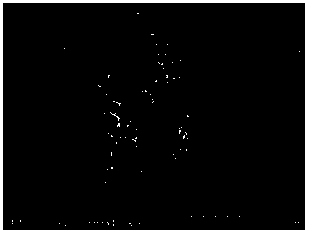A method for in-situ coating of aluminum oxide insulating layer on the surface of metal soft magnetic powder
An aluminum oxide, metal soft magnetic technology, applied in magnetic objects, metal processing equipment, magnetic materials, etc., can solve the problems of poor thermal stability of polymer insulating layers, low bonding strength, uneven insulating coating layers, etc. Achieve high saturation magnetic induction, low loss, high utilization, and thin coating
- Summary
- Abstract
- Description
- Claims
- Application Information
AI Technical Summary
Problems solved by technology
Method used
Image
Examples
Embodiment 1
[0028] Weigh three parts of 10g iron powder, the uncoated iron powder has a smooth surface, but has obvious pores, and the appearance is as follows: figure 1shown. According to the mass conversion of 0.1 g of elemental aluminum, weigh the aluminum sulfate compound with the corresponding aluminum molar amount, and prepare three solutions of 30 mL with deionized water. At the same time, the other part was used as a comparative example without adding surfactant. The pH of the solution was then adjusted to 6 by adding sodium acetate-acetic acid pH buffer. Add iron powder and aluminum salt solution into the hydrothermal reaction kettle, and stir for 20 minutes to make the metal magnetic powder evenly dispersed; place the hydrothermal reaction kettle in an oven, set the temperature to 55 °C, and keep the holding time for 3 hours to obtain Precursor-coated metal magnetic powder; the obtained precursor-coated metal magnetic powder is washed with water, magnetically separated, alcoho...
Embodiment 2
[0033] Weigh six parts of 10g iron-silicon-aluminum magnetic powder for each. According to the mass conversion of 0g, 0.01g, 0.1g, 0.15g, 0.2g, and 0.25g of elemental aluminum, weigh six parts of aluminum nitrate compound with the same molar amount as elemental aluminum respectively, and use deionized water to prepare six parts of 30mL each. solution. Add 0.15 g of surfactant sodium dodecyl sulfonate to each solution, stir well, and then add sodium dihydrogen phosphate-disodium hydrogen phosphate pH buffer to adjust the pH of the solution to 7. The iron-silicon-aluminum-based magnetic powder and the aluminum salt solution were added to the hydrothermal reaction kettle, and the stirring time was 20 min to make the metal magnetic powder evenly dispersed; 4h, the metal magnetic powder coated with the precursor was obtained; the obtained metal magnetic powder coated with the precursor was subjected to magnetic separation, water washing, alcohol washing, magnetic separation, dryin...
Embodiment 3
[0037] Weigh three parts of 10g iron-nickel-molybdenum magnetic powder. According to the mass conversion of 0.16 g of elemental aluminum, weigh the aluminum chloride compound of the corresponding aluminum molar amount, make a solution of 30 mL with deionized water, and add 0.005 g of surfactant DTAB to the solution, and stir well. The pH of the solution was then adjusted to 5 by adding sodium acetate-acetic acid pH buffer. The iron-nickel-based magnetic powder and the aluminum salt solution were added to the hydrothermal reaction kettle, and stirred for 20 minutes to make the metal magnetic powder evenly dispersed; the hydrothermal reaction kettle was placed in an oven, the temperature was set to 40 °C, and the holding time was 3 hours. , to obtain precursor-coated metal magnetic powder; the obtained precursor-coated metal magnetic powder was washed with water, magnetically separated, alcohol washed, magnetically separated, dried, and calcined at 900 °C for 3 h to obtain alumi...
PUM
| Property | Measurement | Unit |
|---|---|---|
| saturation magnetic induction | aaaaa | aaaaa |
Abstract
Description
Claims
Application Information
 Login to View More
Login to View More - R&D
- Intellectual Property
- Life Sciences
- Materials
- Tech Scout
- Unparalleled Data Quality
- Higher Quality Content
- 60% Fewer Hallucinations
Browse by: Latest US Patents, China's latest patents, Technical Efficacy Thesaurus, Application Domain, Technology Topic, Popular Technical Reports.
© 2025 PatSnap. All rights reserved.Legal|Privacy policy|Modern Slavery Act Transparency Statement|Sitemap|About US| Contact US: help@patsnap.com



